

THE BROWN DAILY HERALD
UNIVERSITY NEWS
Incoming provost details path to Brown
How Harvard’s dean of engineering became Brown’s newest chief academic officer
BY NATALIE VILLACRES SENIOR STAFF WRITER
Francis J. Doyle III is a sailor, a passionate soccer referee and a father of three.
He’s also partially responsible for the development of the artificial pancreas — and has steered Harvard’s School of Engineering and Applied Sciences for over seven years.
In July, he’ll become Brown’s 14th provost.
In entering this new chapter, Doyle told The Herald he hopes to bring the leadership and bridge-building skills that have defined his career thus far to College Hill — while advancing Brown’s research innovation with a focus on inclusion and excellence.
Engineering excellence Doyle’s father — a first-generation college student and chemical engineer — quickly became a model for his fu-
METRO
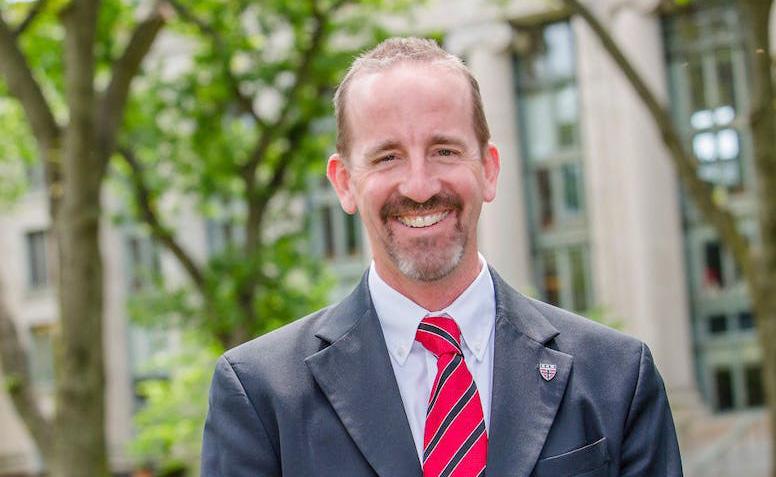
ture as an academic and scholar, he said. Alongside his siblings, Doyle’s parents instilled the importance of a college education within their children, prompting each of them to pursue an undergraduate degree at their chosen institutions.
After graduating high school in Delaware, Doyle went on to study chemical engineering and receive curricular training at three private institutions — Princeton, Cambridge University and the California Institute of Technology — each of which shaped his educational
Construction company charged for waste disposal
Alleged actions on 6/10 interchange project posed environmental risks
BY MAHIN ASHFAQ SENIOR STAFF WRITER
On Jan. 18, Rhode Island Attorney General Peter Neronha P’22 charged Barletta Heavy Division, a Massachusetts-based construction firm responsible for the Route 6/10 Interchange project, and Dennis Ferreira, a former Barletta senior employee, with four counts each surrounding the alleged illegal disposal of solid waste at multiple sites in Providence.
“I believe in those charges, but we need to prove them in (state) court,” Neronha told The Herald.
Barletta and Ferreira both pleaded not guilty in Providence Superior Court Feb. 7, WJAR reported.
Separately, Barletta agreed to pay the federal government “more than twice the amount paid by the government as a result of the conduct” last October. And last December, Ferreira pleaded guilty in federal court to three counts of making a false statement in
connection with a federally funded highway project regarding the origin and environmental compliance of materials for the interchange. The United States has also entered into multiple non-prosecution agreements surrounding Barletta’s actions during the construction of the 6/10 project.
“Personally, I’m glad that both the U.S. Attorney’s Office and the (Rhode Island) Attorney General’s Office went after this case and made a big deal out of it,” said Margaret Curran, senior attorney at Conservation Law Foundation Rhode Island, who is not affiliated with the case. “People are harmed, and cleanup can take forever and there’s no one around to pay for it.”
According to local community organizations and court documents, Barletta’s alleged illegal dumping of thousands of tons of contaminated waste poses an environmental risk to surrounding communities in Providence.
Barletta was contracted for the completion of the Route 6/10 Interchange project in 2017, which involves constructing the “entire interchange”
journey, he said. Throughout the first phase of his early career, Doyle worked at three public colleges, teaching at Purdue University, the University of Delaware and the University of California at Santa Barbara.
“It struck me that I had this amazing and wonderfully unique experience of having both lived in the private university world as a student and trainee, and then having worked as a faculty member for so many years in public
ARTS & CULTURE
UNIVERSITY NEWS
Study abroad draws closer to pre-pandemic numbers
Students, study abroad staff discuss program changes, locations, lack of restrictions
BY KATIE LI CONTRIBUTING WRITER
A total of 266 students — the largest number since the start of the COVID-19 pandemic — are studying abroad in 28 different countries this semester, according to Senior Associate Dean of the College for Study Abroad Malik Blue.
The most popular destinations this semester are the United Kingdom, Spain and Denmark, according to Blue. Ten or more Brown students are also studying abroad in each of France, New Zealand, Ireland and Italy. Students are participating in study abroad programs in every continent other than Antarctica.
The size of this year’s cohort reflects a steady uptick in students studying abroad throughout recent
semesters, Blue wrote in an email to The Herald. Though there has been an increase since the start of the pandemic, he also noted that this semester’s cohort is smaller than that of the 2018-19 and 201920 academic years, each of which saw between 350 and 400 students studying abroad.
Although the pandemic’s effect on study abroad programs is significantly less pronounced than in previous semesters, ongoing program, institution and government health and safety restrictions are still in place, along with an overarching restriction on homestays, Blue added.
For William Forys ’24, who is studying abroad in Granada, Spain, the restriction on homestays meant that he was not able to apply to programs in several Spanish cities. The restriction on homestays will be lifted in fall 2023, according to Blue.
This semester, about 35% of-
Em’s Femmes busts jams, builds community
Band aims to foster synergy, write music, create supportive space for femme artists
BY ISABEL HAHN CONTRIBUTING WRITER
The members of all-femme funk and jazz band Em’s Femmes initially assem bled due to a shared love for jamming out and a wish for more gender-inclusive jazz spaces. Em’s Femmes, now over a year old,performs regularly and its eight members continue to support each others’ creative endeavors.
Currently,Em’s Femmes is made up of Melody Trautner ’25.5 (keys), Coco Kaleel ’24 (saxophone and trumpet), Marina Benson’24 (vocals),Addie Clark ’24 (keys), Emma Venarde ’24 (bass), Dana Lee’23 (clarinet),Sheridan Feucht ’23 (drums) and Sophia Wotman ’26 (trumpet).
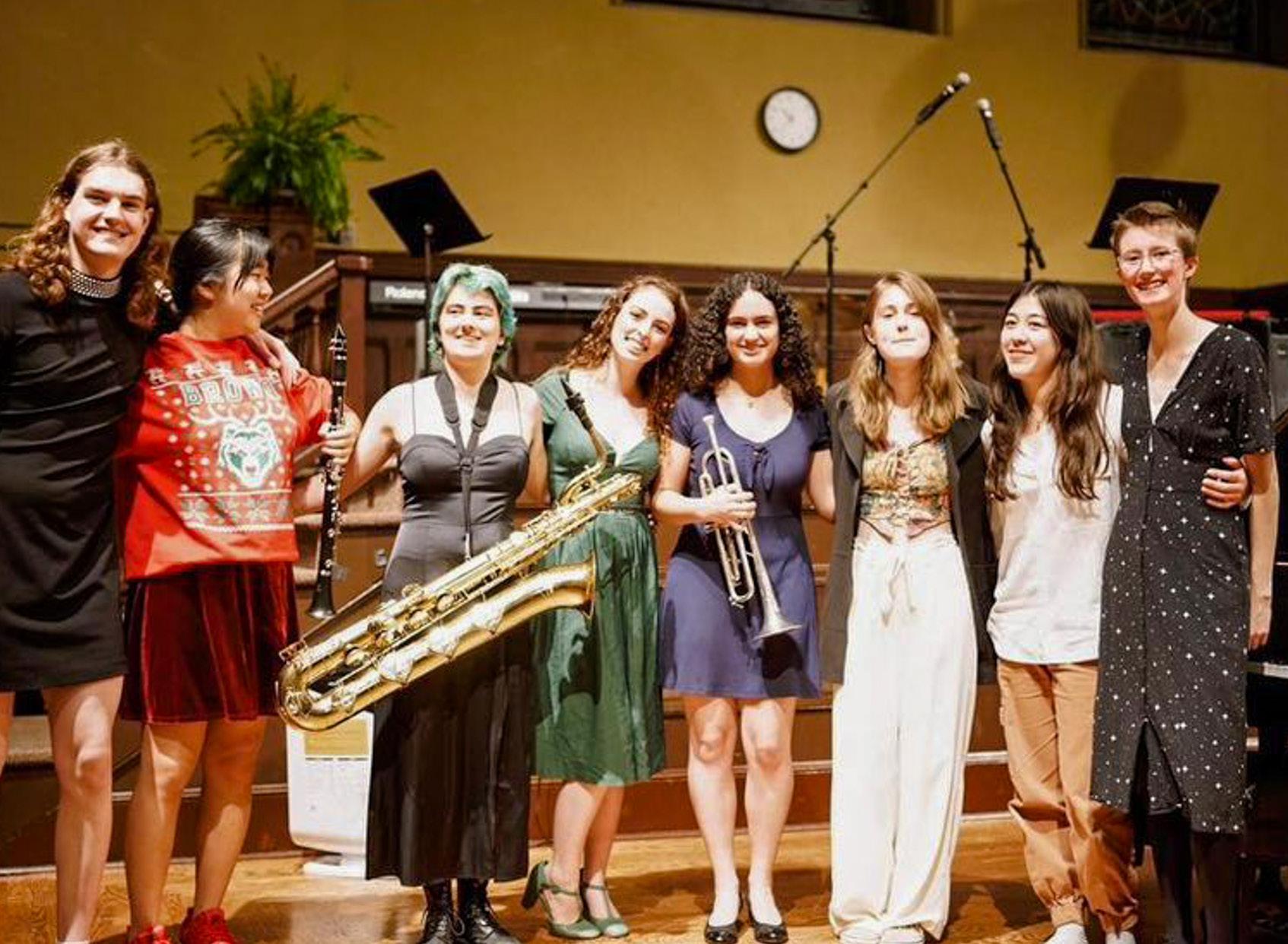
Assembling the femmes: Getting the band together
Trautner con-tacted several of the members in the fall of 2021 to discuss starting a band. This invitation met with enthusiastic agreement, according to Kaleel.
The band initially set up and started practicing in the basement of North House, one of the University’s two Environmental Program Houses, and the next semester played at the University’s Orchestra Winter Ball. Lee was invited to join as clarinetist before the Winter Ball gig, and Wotman as trumpet player the following school year.
“I remember … being really bummed out about my music playing and rolling up to jam with them at orchestra ball, and it ended up being one of the


best-ever jazz musical experiences I’ve had at Brown,” Lee wrote in an email to The Herald.
Wotman was invited by Lee to play in the band after saying that she wanted to meet more femme jazz musicians. She quickly fell into a rhythm with the band.
“I was incredibly nervous at first, but the second I stepped into the room, I instantly felt a sense of belonging,”
The band was created to make space for femme artists as well as to foster a community for musical experimentation.
COURTESY OF HARVARD SCHOOL OF ENGINEERING
“Brown was the absolute optimal place for my next administrative chapter,” incoming provost Francis J. Doyle III said.
SCIENCE & RESEARCH
U.researchers publish findings on ideological neural polarization
Participants across political spectrum process information differently, study says
BY GABRIELLA VULAKH SENIOR SCIENCE AND RESEARCH EDITOR
A study from University researchers published earlier this month in the journal Science Advances found that the brains of people with the same ideological beliefs process political content similarly — and that the brains of liberal-leaning individuals process this information differently from those of conservative-leaning individuals.
When “the brain interprets the world around us … there’s just a stream of information, and the brain has to take all of that information that is being processed through the different senses, and it has to make sense of that information in a useful way,” said Oriel FeldmanHall, associate professor of cognitive, linguistic and psychological sciences and one of the study’s authors.
FeldmenHall described a process called “segmentation” for processing information. Brains of conservative individuals segment chunks of information in ways that are similar to one another — but that are “very” different from the ways liberal individuals segment that same political content, according to FeldmanHall.
Seeing this difference in how partisans interpret political information led the researchers to ask what was causing this response, and at what level in the psychological processing stream it was occurring, according to study author Daantje de Bruin GS, a
SPORTS

first-year graduate student in FeldmanHall’s lab.
“We don’t say that because you have this political ideology your brain works in this way or because your brain works in this way you have this political ideology because we cannot really make those claims — so that’s an important nuance,” de Bruin said.
“But we do see that political partisanship and polarization expresses itself even at the neural level.”
The study asked participants to report their political ideology on a 0-100 scale using a slider ranging from “extremely liberal” to “extremely conservative,” with zero falling on the liberal end of the scale and 100 on the conservative end, according to de Bruin. Participants who reported a score below 50 were categorized as having a liberal ideology and those who reported a score above 50 were categorized as having a conservative ideology.
The study recruited 360 potential
participants through posters, flyers, advertisements and visits to political meetings and political organizations.
From those potential participants, 44 individuals — 22 liberals and 22 conservatives, matched in gender distribution and educational level between the two groups — were selected, according to de Bruin.
Participants performed a series of experiments including a word placement task in which they placed 30 words related to political issues such as “abortion,” “freedom,” “police” and “immigration” in a circle based on how strongly they associate these words with each other.
Following this task, participants were placed into a functional magnetic resonance imaging scanner — which measures blood flow in the brain — and were asked to read politically charged words as well as control words with no political connotation to measure brain activity elicited by these specific words.
“The fact that we can just show people words that are slightly political in nature … and already the brain is polarizing that information suggests just how deeply entrenched these politically polarized views are,” FeldmanHall said.
While in the scanner, participants also watched political videos, including a segment of the 2016 vice presidential debate between Virginia Sen. Tim Kaine and former Vice President Mike Pence and a video on abortion legislation changes.
Participants “could see the same political information and yet a Republican and a Democrat (would) come out of that same scenario saying two different narratives of what happened,” FeldmanHall said.
Yuan Chang Leong, an assistant professor in the Department of Psychology at the University of Chicago, found similar results in his own research. In a 2020 study Leong co-authored examining how conservative and liberal ideologies drive neural polarization, he found that “despite watching the exact same video, the neural responses diverge between participants with different political beliefs.”
The areas of the brain most involved in the segmentation process and synchronized responses were the amygdala and the striatum — regions involved in emotional processing and value-based decision making respectively, according to FeldmanHall. These areas “make sense because we’re talking about how people are listening to and processing content that they come to value and have emotional experiences around,” she added.
Similarly, Leong’s paper found that the magnitude of neural polarization was stronger when participants watched videos that included “emo -
tional or threat-related language.”
“This paper gives us new insight into what might actually be driving these divergent responses that we see,” Leong said, adding that while his paper argues that neural polarization is driven by the language that people use, the paper from FeldmanHall’s lab builds on this idea by suggesting that the polarization is actually a result of “what these words mean to different groups.”
“These words carry the same connotation for people within an ideology and different connotations between people with different ideologies,” Leong explained. “That predicts the degree to which our brains respond.”
Since the data used in this study was collected in 2019 “when immigration was a very hot topic, … if you collected data now other things like abortion might be way more polarized just because of recent developments in the country,” de Bruin said. “It (would) be cool to integrate those recent developments into future studies.”
“I think it’s an innovative (and) important paper,” Leong said. “It’s a data set that’s also very unique, that came at a time when political polarization was a very big problem.”
Leong added that the new study’s ability to bring together people with different political beliefs and collect this data was “a Herculean effort.”
Moving forward, the researchers plan to investigate how other parts of the body respond to these political phenomena. FeldmanHall said that the researchers hope to use variables such as eye tracking, which can measure attention, and skin conduction or hand sweating, which can measure emotional arousal, to “get a more holistic picture of how people are responding to political content.”
Gymnastics lands fifth straight home victory against Springfield
Julia Bedell ’25 ties school record on floor, team posts season highs on vault, floor
BY HALEY SANDLOW UNIVERSITY NEWS AND SCIENCE & RESEARCH EDITOR
The gymnastics team triumphed over Springfield College Sunday, capping off a stretch of home meet victories dating back to late January. The Bears tallied a final score of 194.325, setting season highs on both vault and floor with a school record-tying 9.925 from Julia Bedell ’25 on floor.
“Where we’re at is perfect,” said Head Coach Brittany Harris. “We really just wanted to celebrate every routine, every moment (and) every stick and just use that momentum to help carry us through the meet.”
The Bears started on vault, notching two 9.725 scores from Lauren Kramer ’24 and Angela Xing ’24, as well as a 9.775 from Umi El Mammann ’26. The Bears capped off the rotation with a 9.800 from Abby Contello ’23 and a 9.825 from Bedell, contributing to their season-high total of 48.850 in the event.
“We really got out there and we were confident,” Contello said.
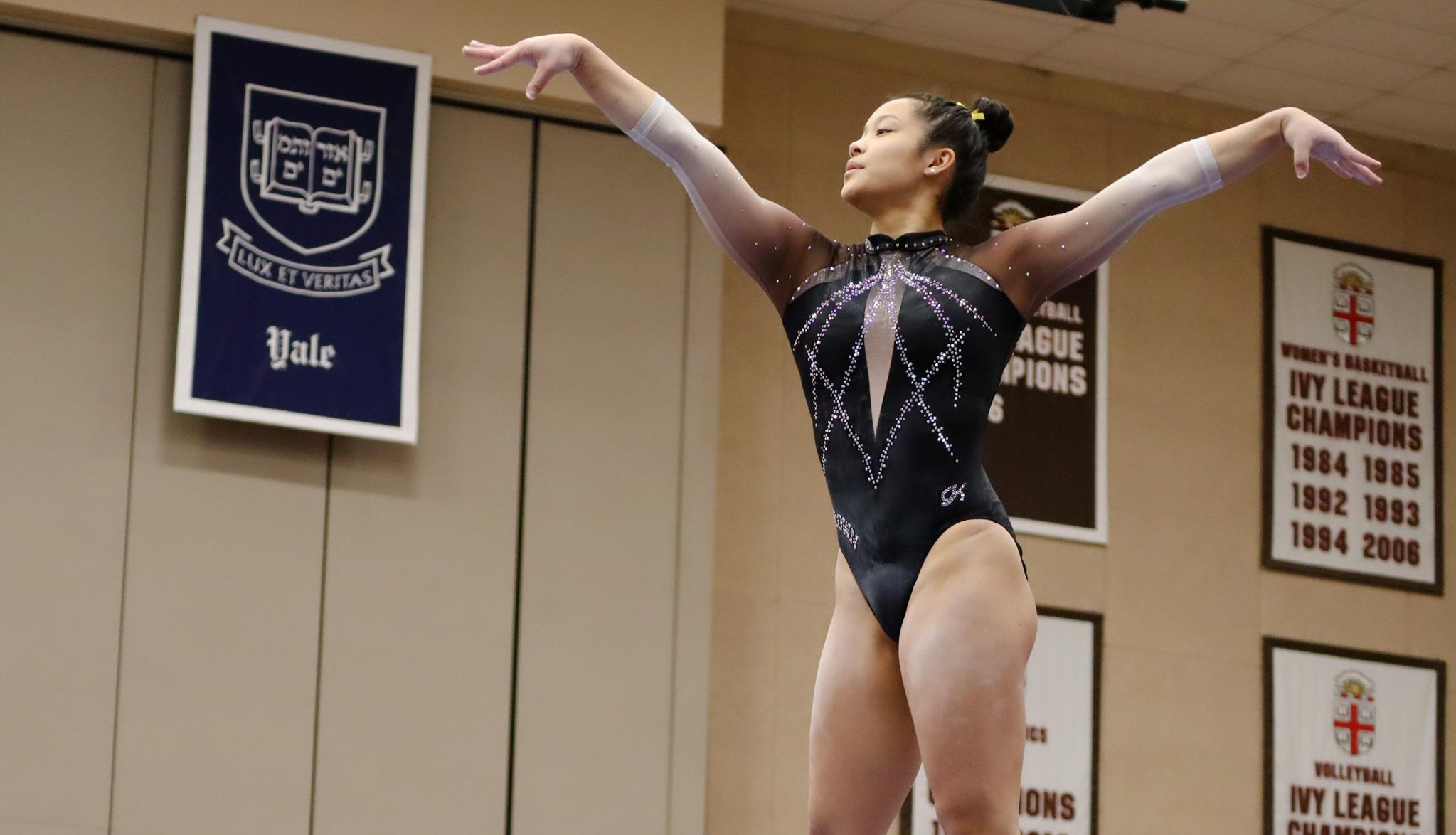
exciting to watch her.”
“The team is building in a really great direction, so I’m really excited to see what the rest of the season has to hold,” Bedell said.
With a 194.325 Sunday, the Bears earned their second-highest score this season after last weekend’s win against Southern Connecticut State University, with a score of 194.775. After awards, Brown honored its five seniors, sharing personal highlights and emphasizing the class’s resilience throughout their seasons affected by COVID-19.
“We just really wanted to … celebrate the seniors (and) everything they’ve accomplished over the years,” Harris said. At the meet, all of Brown’s gymnasts also wore a yellow ribbon in her hair in support of Handstand Walk for Kids, an organization that raises money for pediatric cancer research.
9.750s, and Contello took first on the event with a 9.775, nailing her double layout dismount. Up next on beam, the Bears also endured a rocky start with a fall early in the lineup, but quickly bounced back with a 9.700 from Herald Staff Writer Maya Davis ’25, and a 9.725 from Liza Marcus ’26. Xing competed last, scoring a 9.825 to wrap up the team’s rotation
After a stumbling start on bars, the Bears bounced back with clean release skills and stuck dismounts for a team score of 48.000. Lauren McKeown ’24 and Ella Poley ’23 posted back-to-back
of powerful acro series and stuck dismounts.
With a total of 145.375 leading into floor, the team’s energy was high. Kramer nailed her double back to post a 9.825, and Davis snagged a 9.850 in her floor routine to an instrumental version of “So This Is Love” from “Cinderella.”
In the final competing slot of the meet, Bedell took the floor to an instrumental version of Demi Lovato’s “Confident,” performing a new skill for the first time — a full-in, or a full-twisting
double back. The routine earned her a 9.925, tying the school’s record on floor.
“It’s crazy, it still hasn’t really sunk in yet,” Bedell said. “I’m excited (to see) where I can take this floor routine and maybe even potentially score higher.”
“We’ve been slowly building up to adding that full-in into that first pass of her routine,” Harris said. “She did some great ones during practice during the week, and I knew when she was going that it would click … so it was super
Taking place midway through the season, Sunday’s meet was a “progress, not perfection meet,” Harris added. “We don’t want to peak too soon. … That way when we start hitting championship season, with the Ivies coming up, we’ll start hitting those marks where we want to.”
Brown gym will look to carry their energy and build on their scores at the Long Island University Quad Meet in Brookville, New York on Monday and at the Ivy Classic the following weekend at the Pizzitola Sports Center.
CYNTHIA ZHANG / HERALD
CLAIRE DIEPENBROCK / HERALD
In addition to honoring the team’s five seniors, the meet was dedicated to the fight against pediatric cancer, and each gymnast wore a yellow ribbon in her hair in support of Handstand Walk for Kids.
‘Women Talking’ falls short, fails to capitalize on compelling concept
Best Picture nominee does little to captivate audience, demonstrate subtlety
BY FINN KIRKPATRICK ARTS & CULTURE EDITOR
Content warning: This article includes mentions of sexual assaults that occur in the movie “Women Talking.”
“Women Talking” presents a very self-explanatory title. Most of the film is just that — women talking. But that is not to trivialize what exactly they are talking about. The women are all members of an isolated Mennonite colony in 2010 — though they could just as easily be living in 1810, given their complete lack of technology and modern conveniences. Aside from a brief scene where someone from the Census Bureau comes to survey the colony, there are no signs of a world outside their own. Central to the plot is the women’s discovery that some of the men of the colony have been using cow tranquilizer as an anesthetic in order to rape them. Those charged have been sent to a jail in a nearby town, with the remaining men joining them to handle the bail.
This leaves the women by themselves to ponder a single question: Should they leave the colony alto-
UNIVERSITY NEWS
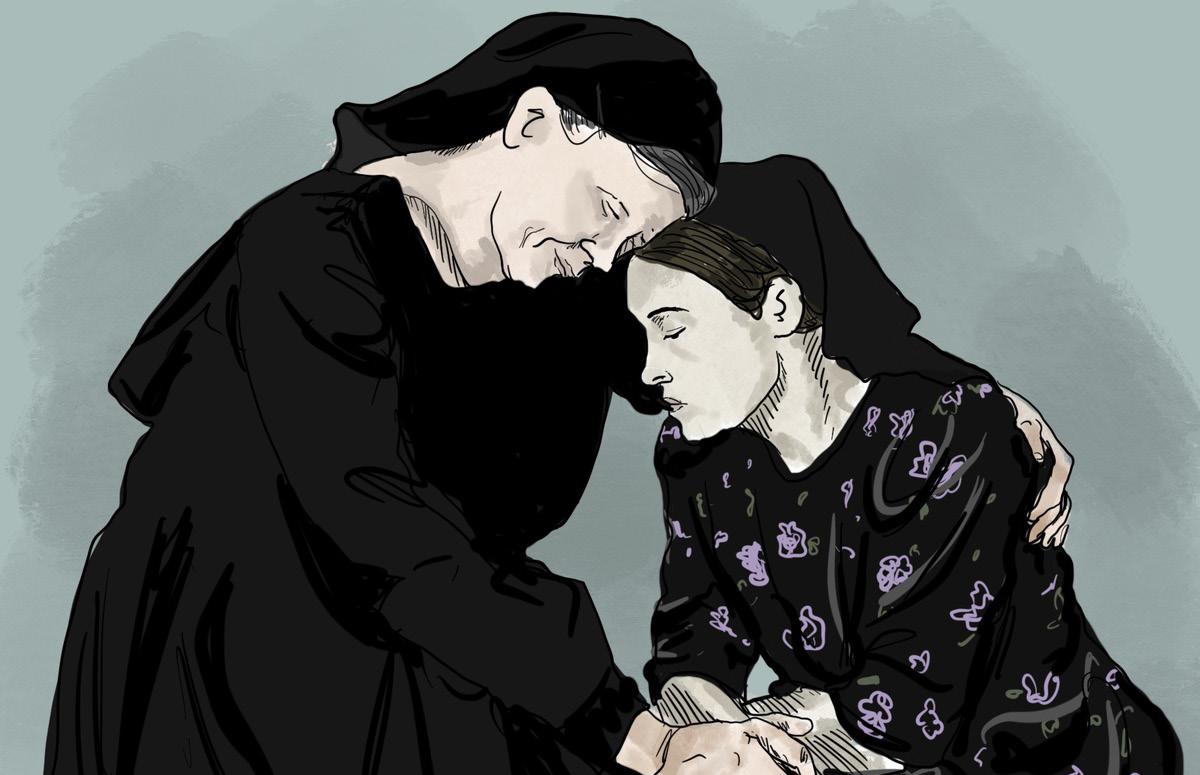
gether? A vote is held to consider three options: stay and do nothing, stay and fight or simply leave. The vote results in a tie, with the women split between leaving or staying and fighting. After the vote, eleven of the women of the colony convene in a barn to have a more in-depth discussion of the matter. Joining them is August (Ben Whishaw), a noble schoolteacher and one of the only two men not implicated in the crimes of the colony’s other men. He is there to transcribe the events of the meeting, as none of the women are allowed to learn
how to read and write. Ona (Rooney Mara), who is pregnant as the result of a rape, believes that if they stay, fight and win, they could rewrite the rules and create an equal society, but Mariche (Jessie Buckley) believes the only way to move forward is through forgiveness. When this decision causes further disagreement amongst the group, August drafts a list of the pros and cons of leaving at Ona’s encouragement. Behind the choice the women face is a compelling exploration of a crisis of faith. These women are all deeply
religious individuals and wholeheartedly believe in the doctrines of their colony, and yet men who take part in the very same doctrines are committing unspeakable acts. For the first time, they are now reckoning with ideas they have been told for too long not to question. But while the film is structured around an interesting concept with important and complex themes, there is nothing stylistically done to let any of that pop. The film is shot entirely with a muted gray color palette which,
while executed well in the context of what the film was trying to achieve, is ultimately unpleasing to the eye. The screenplay, which is also good by all technical standards, is overwritten to oblivion; the film’s lack of subtext ensures that the audience never has to grapple with what is placed in front of them. The film demonstrates why the old adage of “show, don’t tell” is important. And the film does not have much more than its screenplay to rely on. Through its dialogue-reliant script and static staging, it feels more like a play on film instead of a full-fledged movie. There would be minimal difference if “Women Talking” was viewed entirely with your eyes closed, just listening to the audio.
The film has a powerhouse cast, including actors Rooney Mara, Claire Foy, Jessie Buckley and a brief appearance by Frances McDormand. But their performances fall victim to the same crime as the screenplay — an excruciating lack of subtlety.
“Women Talking” is certainly not a bad film. It offers a glimpse into a world that seems so foreign and detached and yet still exists to this day. If you watch the movie exclusively as a work of semi-fictional cultural anthropology, there is plenty to like. But as a complete cinematic experience, it falls short. In the end, “Women Talking” tries so hard to make something audiences would deem “important” that it forgets to make a movie that feels complete.
English nonfiction program’s mandatory S/NC elicits mixed feelings
Professors say program aims to encourage exploration, students express concerns
BY SOFIA BARNETT UNIVERSITY NEWS EDITOR
Since its founding in 1997, the University’s English nonfiction program has offered a variety of courses exploring the academic essay, narrative writing, journalism and more to students from any concentration at the University.
While the nonfiction track offers students a multitude of classes to choose from, the program has one non-negotiable rule: Each student is evaluated under a mandatory Satisfactory/No Credit grading system.
“From the outset, we decided to make S/NC mandatory primarily because we wanted, and still want, students to work on their writing for themselves rather than for a grade,” said Senior Lecturer in English Lawrence Stanley, who was involved in the founding of the program.
The program seeks to allow students “to experiment and to take risks and to work through numerous drafts” in order to get the most experience from the program’s offerings, Stanley said.
But according to Haider Dhalla ’25, the program’s strict S/NC grading system has discouraged him from pursuing courses within the program’s expansive curriculum. Dhalla, who entered the University intending to concentrate in English on the nonfiction track, ultimately decided against the concentration.
“I was considering experimenting with some of the courses in the
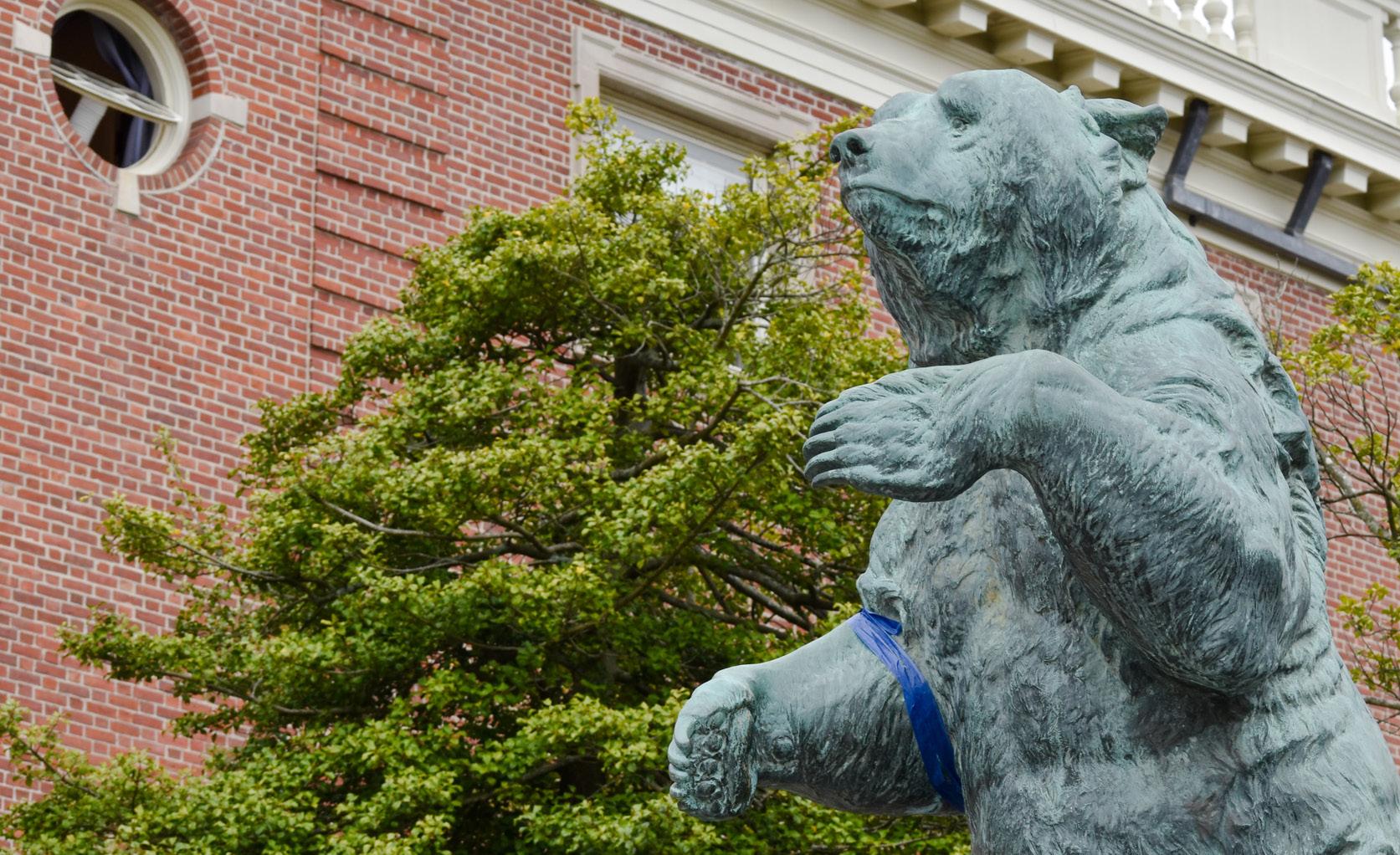
nonfiction department for a while,” Dhalla said. “But the pass/fail policy had a major influence on my decision to switch gears.”
Dhalla explained that while he had considerable interest in the field of nonfiction writing, he would rather have the option to take his classes for a grade in order to demonstrate a strong academic repertoire on his transcript.
“I really wanted the opportunity to … (take classes) for a grade, because if I end up wanting to apply to graduate schools, then I’d be able to show them actual letter grades to prove I can do academic work,” he said.
Dhalla is not alone in his concern about taking primarily S/NC classes. Makieda Mckenzie ’25 explained that as a prospective pre-med student, she feels more inclined to pursue hu-
manities courses that still allow for a quantitative demonstration of her abilities.
“I’m definitely interested in writing, but ultimately, I have to make sure that I can be just as strong of an applicant as other pre-med students who are only taking classes for a grade,” she said. “I’d rather explore other Brown humanities departments that don’t have as rigid (of) a (grading) structure.”
According to Carol DeBoer-Langworthy, senior lecturer in English, the pass/fail system aims to push back against a grade-focused mentality.
“I love the pass/fail system because what we really hope to see is students trying new things and taking risks in these writing courses instead of … trying to figure out what they need to do to please their teacher,” she
said. “I’m always trying to get students to write their own stories and to just write what they think and feel.”
DeBoer-Langworthy acknowledged that while the program’s grading system was established to benefit students, she has heard several complaints critiquing the mandatory structure.
“Plenty of students don’t approve of (the policy),” she said. “I’ve had students lobby me to change an S into an (S with distinction) because it would make the difference between this honor or that honor.”
But for DeBoer-Langworthy, these criticisms of the program’s grading structure are deeply rooted within a larger problem.
“With everybody at all of these colleges now getting all As … the whole grading system is faulty now,
it’s broken,” she said. In the 2020-21 academic year, 67% of grades at Brown were As — and 10% of grades were Bs, The Herald previously reported. The proportion of As awarded to Brown students has risen steadily since the 1990s.
In this regard, the University’s nonfiction writing program restricts students from being consumed by trivial letter grades and encourages them to engage with the course freely and productively, DeBoer-Langworthy said.
Leaving the choice of taking a course S/NC up to students “just doesn’t work,” DeBoer-Langworthy said. “If (students) had the option (of receiving a grade), there would be a divide between the grade-grubbers and the other people who are really wanting to learn something from the process.”
She added that students can also request a course performance report from their professors across all University disciplines if their specific circumstances require measurable academic evaluations.
“A professor can indicate that, had this course been graded, the student would have received whatever score,” she said. “And the student receives that and it can be attached to (their) transcript.”
Above all, students should “realize how important writing is going to be for the rest of your life,” she added.
“Brown students are good writers and they just need to practice more,” DeBoer-Langworthy said. “Stop worrying about the perfect grade. You’re supposed to try to be true to yourself as much as possible. That’s what will make you a better writer.”
ASHLEY CHOI / HERALD
DANA RICHIE / HERALD
Carol DeBoer-Langworthy, senior lecturer in English, acknowledged that while the nonfiction program’s grading system aims to benefit students, she has heard complaints about the S/NC requirement.
and “replacing or removing” structurally deficient bridges, according to the Rhode Island Department of Transportation.
Barletta and Ferreira were charged at the state level for illegally disposing of solid waste from their projects from other sites — an MBTA excavation in Boston and Pawtucket/Central Falls Bus Hub and Commuter Rail Station at the 6/10 site in the Olneyville neighborhood.
“We don’t know the full health implications yet, but our community is very worried about it,” wrote Miguel Sanchez, vice chair of the Olneyville Neighborhood Association Board and city councilor for Ward 6, in an email to The Herald.
“The action by this company is intolerable and we commend the AG office for taking action on this matter,” Sanchez wrote. “Anyone who is committing environmental injustices must be held accountable.”
The third count against Barletta states that Ferreira and the company operated a solid waste management facility without the approval of the Rhode Island Department of Environmental Management. By allegedly bringing outside material to the 6/10 site, Barletta was “effectively operating a solid waste management facility without being licensed,” Neronha said.
Ferreira and Barletta were also accused of providing false statements on “testing performed on materials that were imported from Massachusetts” to officials from the Rhode Island Department of Transportation, according to court documents from the Attorney General reviewed by The Herald.
“We hope that this action by the (Attorney General’s) office sends a strong message that these types of injustices will not be tolerated anymore,” Sanchez wrote.
Because Ferreira was the superintendent of the 6/10 project, he was “responsible on-site for everything
that happened there,” Neronha added. “The company is responsible for his conduct.”
Ferreira and his attorney did not respond to multiple requests for comment by publication time.
Following the release of state-level charges, Barletta released a threepage statement “respectfully” rejecting Neronha’s charges.
“None of the soil and stone transported to the 6/10 job was solid waste,” the statement reads. “The soil and stone transported to the 6-10 highway job was the same in composition and makeup as the urban soil already present in, around and under the 6-10 highway for generations.”
The statement added that the charges brought against Ferreira represent the “unauthorized actions of (a) former employee.”
“Mr. Ferreira acted independently without the authorization, knowledge or consent of Barletta, and … that upon Barletta learning of that employee’s conduct, his employment was terminated,” the statement reads.
Barletta did not respond to multiple requests for comment from The Herald.
Toxic materials from Pawtucket and Boston allegedly brought to Providence In 2019, BETA Group, Inc., the environmental consultant for the Pawtucket site, submitted a site investigation report to RIDEM detailing “contaminated soil” with contaminants including arsenic and hydrocarbons. “Unrestricted” future use of the soil could have posed risks, according to a police narrative included in the court documents.
Barletta also worked on MBTA railroad projects in the Boston area, which involved ballast stone replacement for the stone used under the tracks, according to the police narrative. Excavation plans required any stone used offsite to be tested beforehand.

Because the 6/10 project required “large amounts of gravel,” Barletta allegedly began making its own gravel partially from the Boston stone in July 2020, though the stone had not been tested, according to the narrative. Additionally, it claims that Barletta dumped 1,144 tons of the contaminated soil from Pawtucket between two sites in Providence.
Complaints about the ballast began to circulate in 2020 when a Local Union 57 operator allegedly complained “about the dry conditions at the work site, as well as the apparent composition of the materials” being dumped in the Olneyville stockpile, according to the police narrative — a complaint eventually reached RIDEM. Local Union 57 did not respond to multiple requests for comment.
“I think it’s pretty outrageous the way that it came to light through the union,” Curran said.
The police narrative also alleges that Ferreira used an environmental report from a different ballast site where the level of contamination met state requirements in place of testing

CALENDAR
the ballast from the MBTA project.
The soil transported from Pawtucket first came to light when a RIDOT inspector “confronted Ferreira” about removing soil from the site, according to the narrative. RIDOT declined to comment on the active case.
RIDEM eventually tested soil samples from the Route 6/10 connector construction site, finding “elevated levels of chemicals that occur naturally in coal, crude oil and gasoline,” Michael Healey, chief public affairs officer at RIDEM, wrote in an email to The Herald.
“These chemicals result from burning coal, oil, gas, wood, garbage and tobacco and are often found in the soil of cities with industrial histories, like Providence,” Healey wrote. “They have a low degree of acute toxicity to humans, but they’re still toxic.”
Barletta’s statement placed the blame for the transfer of the materials on Ferreira, who allegedly did not have the “knowledge or authorization of Barletta,” and additionally claimed that the materials were not intended
to be discarded, while challenging that the soil counts as “solid waste.”
“The soil at issue is ‘urban fill,’ which is commonly found in city settings throughout the United States, particularly around highways located in urban areas like the 6-10 highway project,” the statement continues.
“It takes a while to investigate matters like this,” Curran said, noting that it took nearly three years to prosecute Barletta following initial complaints. “Environmental crimes can be harder to prove.”
Neronha said he anticipates a trial, but that Barletta may file motions to dismiss.
“I hope that individuals alleged to have committed these irresponsible and negligent environmental crimes are met with justice,” Providence City Councilor Oscar Vargas said in a statement. “Olneyville has long suffered from poor community health outcomes and the reckless actions of wealthy corporations only exacerbates this issue.”
“Rhode Island,” Vargas told The Herald, “is not a dumping ground.”
TODAY’S EVENTS
students studying abroad are doing so through University-administered programs, with the other 65% participating in approved external programs, Blue wrote. He added that students usually consider factors such as language, location, academic offerings and opportunities in making their decision and that the program type alone is generally not a deciding factor.
Students told The Herald that program directors and advisors played an instrumental role in helping choose programs, handle logistics and create a positive experience. “One of my friends said that ‘they just want to see your study abroad dreams come true,’ and I would certainly second that point,” Forys wrote in a message to The Herald.
Edna Agyemang ’24, who is studying in Cape Town, South Africa, explained that immersion in a different country has provided valuable opportunities for educational and personal growth.
Forys wrote that his program in Granada provides a detailed look at important events in Spanish history — including the Spanish Civil War and Francisco Franco’s dictatorship — and the way Spaniards have me -
universities,” Doyle said. “It gave me, I think, a very balanced perspective on universities.”
During his time as an academic and research administrator at UCSB, Doyle began his work on the artificial pancreas, a device for individuals with type 1 diabetes to help them normalize their blood sugar levels. For approximately 30 years, Doyle’s work earned public recognition, exposing him for the very first time to the connections between different fields.
“My work, by its nature, is very interdisciplinary,” Doyle said. “We can’t do it alone as (chemical) engineers.”
Over the years, Doyle has collaborated closely with electrical, computer, mechanical and biomedical engineers to advance his findings, in addition to working with medical doctors. Doyle recalled his first meeting with a medical doctor as a “proverbial research marriage made in heaven.”
“She said, ‘You’ve got the algorithms my patients need,’ and I said to her, ‘You’ve got the patients I’d love to bring
Wotman wrote in an email to The Herald. “I played at WaterFire with everyone, just a week after joining. It’s truly a moment I’ll always remember.”
‘A powerful moment’: Synergy and musical chemistry
The open, synergetic nature of Em’s Femmes’ rehearsals has been a highlight for band members. Kaleel described the difficulties of starting college during the pandemic. “There were no clubs, no in-person activities at all,” Kaleel said. “I really missed playing with people, and I didn’t remember how badly I missed it until the first rehearsal.”

morialized these traumatic events.
“This has absolutely helped me manage some of the difficulty of being in a new place by explaining the reasons for some of the everyday
our technology to help.’ ”
In 2015, Doyle earned the American Automatic Control Council Control Engineering Practice Award. That same year, he was appointed Dean of Harvard’s John A. Paulson School of Engineering and Applied Sciences, where he looked to facilitate the school’s research and academic expansion.
Doyle’s tenure marked a self-described “growth phase” for the engineering school: Student enrollment increased, and the school added new entrepreneurial programs as well as multiple collaborative joint degree programs with Harvard’s Graduate School of Design, its business school and its undergraduate college.
Lawrence Bacow — Harvard’s outgoing president — dubbed Doyle the “connective tissue within Harvard,” praising his continued efforts to connect different pieces of the college, according to a Harvard press release.
The School of Engineering holds a reputation as the “bridge-builders of Harvard,” Doyle said.
In 2021, he was elected to the Na-
playing it,” she said. The first time they played, “it was such a powerful moment. We were all screaming and yelling … jumping around (while) playing in that basement.”
All of the members of Em’s Femmes are classically trained jazz musicians, and they perform often as small jazz ensembles, according to Kaleel.
differences we’re noticing,” he wrote. He added that meeting international students from all over the world has been a highlight of his stay in Granada.
tional Academy of Engineering, one of the field’s most prestigious distinctions.
Entering the ‘next administrative chapter’
Doyle was “on cloud nine” in his position at Harvard, he said — and then he got a phone call.
President Christina Paxson P’19 called Doyle in October, telling him that his “name had come up” in the search for a new provost, asking Doyle to discuss the position.
At the time, Doyle told Paxson and the search committee he was “not looking.”
“I had, I might argue, one of the greatest engineering dean gigs on the planet,” he noted.
Doyle was initially unaware of the departure of former Provost Richard Locke P’18 and had no prior relationship with Locke before hearing about the position. A career shift was not part of his plan, but Doyle was quickly interested in the offer.
“The reason (the position) intrigued me was that initial conversation with
of rehearsals and performances that has continued throughout the band’s existence, the group has fostered community for its members.
For Agyemang, studying abroad in Cape Town provides opportunities to learn about South Africa’s racial history from African professors. “I have been experiencing a
President Paxson,” Doyle said. “Her leadership style — it came through in that call. She was really engaging and inspiring, and the more I learned about Brown and took a deeper dive, the more intrigued I became.”
In the following weeks, Doyle dedicated his time to “deep soul-searching,” as he grappled with the possibility of leaving his position at Harvard. Ultimately, he decided to pursue the job, hoping to make an impact on a campus-wide scale.
“Brown was the absolute optimal place for my next administrative chapter,” he said.
Going into “learning mode”
On Dec. 15th, Brown University announced that Doyle had been appointed as the school’s 14th provost. Since then, Doyle has been in “learning mode,” including a conversation with Locke where he learned about the role.
Working with provosts in his previous positions has also given Doyle “a peek into the role,” he said.
lot of African cultures, languages and food in a way that I could not at Brown,” she wrote in a message to The Herald.
Interim provost Larry Larson emphasized Doyle’s “ethical and moral sense” along with his valuable past experiences and grasp of university financials — qualifications that the search committee deemed essential in the next elected candidate.
“I think he’s wrestled deeply with all of the issues that we encounter here on the campus … such as diversity, research growth, the importance of teaching,” Larson said. “He’s just this spontaneously eloquent person … and I just think he’s an incredibly great choice for Brown.”
At Harvard, Doyle worked to implement the engineering school’s diversity plan and considers diversity and equity a key pillar of his work. At Brown, he hopes to continue that work while also furthering the school’s aspirations for research growth.
Doyle noted that he is excited to begin his position this summer. Next fall, he hopes to integrate himself fully into the Brown community — beginning, he said, with taking his chocolate lab out for a walk on the Main Green.
Kaleel emphasized how easy it is for the band to jump into random melodies and have fun playing off of each other.
“If you’re like, ‘I want to play this song,’ and people have heard the song before … we can immediately start
Lee wrote that they do “a combination of school and community events,” including performances with Gigs on the Green and Sounds@ Brown. They have also performed at the Providence Wine Bar and WaterFire. Recently, the band performed for Small Victories’ “Winter White Out” party, where they played a mixture of pop and jazz music, as well as some fully arranged original pieces for the first time. “Just to see the energy we had with (the crowd) was the most adrenaline I’ve had getting off that stage,” said Kaleel.
“We also always spend part of rehearsal just chatting and talking about our weeks,” Wotman wrote. “It takes me out of the chaos of my busy week and gives me a warm space to do what I love with people that I love.”
Happiness, respect, passion for jazz: The philosophy of Em’s Femmes Em’s Femmes was founded partly in response to the stressful energy the members felt in male-dominated jazz spaces, which led them to believe their band “should be guided by happiness, mutual respect … and love for music, not the ego or expectation that comes from that,” said Kaleel.
(usually) comes in” when there are slip-ups, Kaleel said, adding that the group strives to convey that “we want you to be here, and we want you to contribute and grow. I think that’s what really helped the band be more interconnected.”
According to Lee, “Em’s Femmes really helps showcase some amazing femme musicians who usually wouldn’t take the spotlight or feel comfortable expressing themselves through music.”
Em’s Femmes also makes time to work on original pieces during their rehearsals, particularly developing chords, melodies and various playing styles. The band performed an original by Wotman, “Homewrecker,” at their last gig, which was “the first time I had ever performed one of my original songs live,” according to Wotman. “It was such a special moment for me,” she wrote.
work on studio recordings of original songs and perform more live shows this spring. “We would like to keep playing bigger shows, but also stay true to our roots at the same time,” said Kaleel. On and off campus, Em’s Femmes promotes its music through Instagram, artwork and word-ofmouth.
With all the live performances, busy rehearsals and experimentation with different sounds, the members of Em’s Femmes continue to find value in musical collaboration, and ultimately in each other.
“I don’t think any of us thought we would’ve gotten this far in just one year with our band, but we’ve done a lot of shows and made a lot of good music,” wrote Lee. “Some of my favorite moments have just been the synergy between different band members … it’s really all the little things that make every moment worth it with these femme friends.” JAZZ FROM PAGE 1
Along with the dynamic energy
This philosophy encourages the band to unapologetically make and enjoy their music, according to Kaleel. “There’s a lot of apologizing that
In the future, the band hopes to
COURTESY OF EDNA AGYEMANG
According to Edna Agyemang ’24, studying in Cape Town has allowed her to learn about and experience African history and culture in a more immersive manner than would be possible at Brown.
Gaber ’23: Nerd culture should include feminine interests
A couple weeks ago, I was talking with a friend about my sister’s love for Star Wars and my brother’s passion for Marvel comics. My friend turned to me and said, “So you’re the only non-nerd in your family.” I grappled with that for a second before I understood what she meant. As a perennial academic overachiever who spent much of her childhood singing classical music and reading dystopian young adult novels, “nerd” seemed like an obvious way to label me. Yet, what my friend seemed to imply was that nerd culture encompasses a much narrower set of interests than I had wanted to believe. Without realizing it, many of us link nerd culture with media and interests geared toward boys and men. The absence of female-oriented entertainment media and overall feminine interests from common conceptions of nerd culture excludes women who want to exercise curiosity and be perceived as intelligent.
Wanting to avoid being cliche, I hesitate to start any sentence with “Merriam-Webster defines X as…,” but this time – I promise –such a sentence is warranted. Merriam-Webster defines “nerd” as “a person devoted to intellectual, academic or technical pursuits or interests.” This broad definition could encompass any number of different interests. Yet, popular culture usually portrays nerds as men interested in science fiction, fantasy and STEM. Nerds are also typically stereotyped as very intelligent. TV shows like “The
Big Bang Theory” depict nerd circles as consisting predominantly of white men who are isolated and lack the social skills to talk to women. The show’s nerds regularly reference media like Star Wars, superhero comics and Dungeons and Dragons. Though none of these media are or should be exclusively for men,
communities that are more easily denigrated than their sci-fi counterparts. The exclusion of such interests from the nerd category seems to imply that a fixation with “Gilmore Girls” over “Battlestar Galactica” conveys vapidity rather than curiosity. Such a distinction has created an internalized misogyny in many
“Expanding the term ‘nerd’ to include people with feminine interests is a step toward leveling the playing field for all of your favorite smart, socially awkward and deeply curious people.”
they are particularly appealing to male audiences and certainly signal that even groups of social outcasts can end up being boys’ clubs. A multitude of online communities exist related to media made for women, yet these communities are rarely labeled “nerds.” Fervent fans of fashion, CW teen dramas like “Gossip Girl,” Taylor Swift and even true crime are just some examples of internet
women, which has led to the “not like other girls” or “cool girl” phenomena wherein women attempt to maintain stereotypically male interests in order to receive male approval and attention.
It may seem like a compliment to exclude these large swaths of women from a label that began pejoratively. However, as time has gone on, the term “nerd” has at times been
trendy and even positive, a term that primarily connotes intelligence rather than social awkwardness. Excluding feminine interests from the nerd canon therefore divorces the characteristic intelligence and intense curiosity of nerdiness from women and femininity. Women should not have to conform to stereotypically masculine interests in order to be perceived as smart, curious and, well, nerdy. Finally, by not labeling interest communities surrounding media targeted at women as “nerd lore,” we erase those communities and the fact that many people fixate on stereotypically feminine media in much the same way that they do on “Star Trek” and “Lord of the Rings.”
Just as women should feel free to pursue interests stereotypically associated with boys and men, women should also feel free to pursue interests associated with their own gender without fear of being stereotyped as vapid or unintelligent. Expanding the term “nerd” to include people with feminine interests is a step toward leveling the playing field for all of your favorite smart, socially awkward and deeply curious people.
Yasmeen Gaber ’23 can be reached at yasmeen_gaber@brown.edu. Please send responses to this opinion to letters@browndailyherald.com and other op-eds to opinions@browndailyherald.com.


BROWN DAILY HERALD

UNIVERSITY NEWS
PPSD college-readiness program to arrive one year later than expected
Search for program director underway, first cohort to come in fall 2023
BY OWEN DAHLKAMP SENIOR STAFF WRITER
In October 2021, the University announced plans to implement a college-readiness program in the Providence Public School District.
The University expected to release “outlines” of the program by May 2022 and to bring in its first cohort in fall 2022, The Herald previously reported.
By last fall, the University shifted to recruit the program’s first students in fall 2023, wrote Marguerite Joutz ’15, chief of staff to President Christina Paxson P’19, in an October 2022 email to The Herald.
The planned program will aim to prepare PPSD students to obtain a degree at selective four-year institutions, with just under one-third of PPSD students currently entering four-year institutions directly after graduation, according to the Rhode Island Department of Education.
The University hopes the program will assist with college readiness by providing “participants with a holistic supportive experience that
ARTS & CULTURE
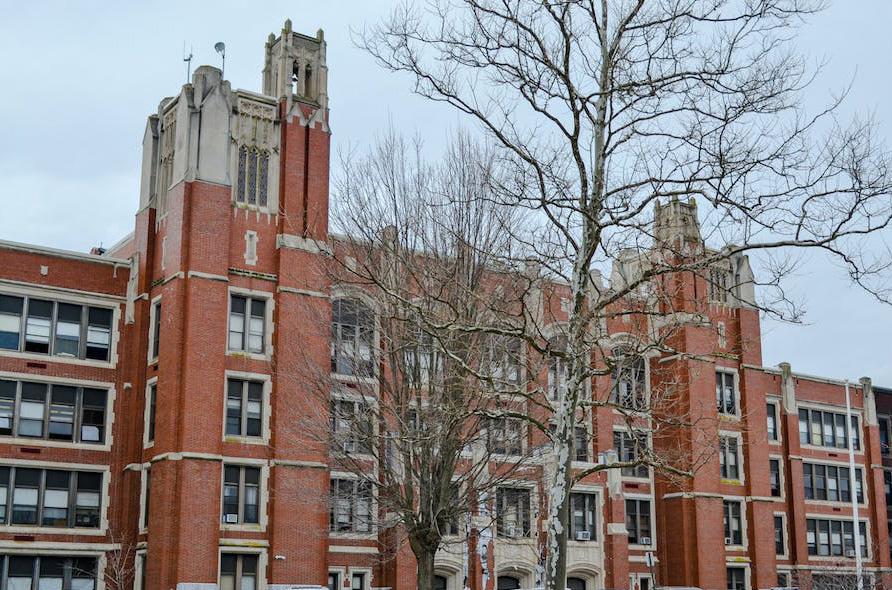
includes academic preparation, individualized college counseling and planning … and identity exploration,” Joutz wrote in a February 2023 email to The Herald.
Joutz added that the program’s mission is to “build, from the ground up, a new college access initiative that will have a transformative impact on the lives of the students who participate.”
Maribeth Calabro, president of the Providence Teachers Union, said she was frustrated with the program’s delay. “We’ve wasted a year and a couple of months now doing nothing,” Calabro told The Herald. When Calabro first heard about
the program in 2021, she was “thrilled.” But now she wants to “see action,” Calabro said.
“They’ve had over 12 months. There should be a plan in place and this should be starting to be implemented and we shouldn’t be waiting to hear what’s next,” she said.
In the October email, Joutz wrote that the University has conducted “more than 50 interviews and focus groups” with Providence high school students, educators, administrators, youth organizations and Brown community members throughout the program’s development.
Calabro said she is aware of “ conversations happening that are
occurring at the district level. But in terms of my colleagues, and folks that I work with at the PTU … (we) have not been privy to that conversation.”
Joutz said that the focus groups and interviews have included “PPSD educators and administrators,” but did not identify specific individuals involved in the conversations.
The University has also gathered “data on the college readiness and matriculation outcomes of students from Providence,” Jourtz said.
In the February email to the Herald, Joutz added that the University’s division of pre-college programs has now formed a search committee for the program director.
“The search committee has met with a number of candidates,” wrote Adrienne Marcus, the head of the committee and dean of pre-college and undergraduate programs, in an email to The Herald. “We hope to find an exceptional person to fill this critical role this spring.”
“I think that there are so many talented students at the Providence Public Schools that don’t necessarily even know that they have the opportunity to go to Brown or any kind of Ivy,” said Nadia Heller ’24, a graduate from Classical High School.
Classical High School, a selective Providence public school, is ranked first among Rhode Island high schools. But even there Heller
described a lack of resources.
Heller and her classmates didn’t have “very personal relationships with guidance counselors,” and did not have college application workshops, she said.
Instead, students used class time to work on their applications — her English teacher set aside time every Friday for students to work on their Common Application essay.
“I hope (the program) works,” she said. “I went to school with … the brightest kids I’ve ever met in my whole life.”
“I hope that it’s an initiative (Brown takes) seriously,” Heller added. “I think (Brown) has a lot of responsibility to Providence Public Schools.”
In developing the program, the University expressed a commitment to “partnership with community members,” according to Joutz.
Calabro said that she hopes the University can create a “collaborative and comprehensive strategic plan to involve every school.”
In regards to the program’s year delay in implementation, “it’s a lost opportunity for those people that we’ve missed over the past year,” Calabro said.
“But it could be a new opportunity, if we can collaboratively come up with a plan and start implementing it in the immediacy.”
Tiny Habits looks to reach new heights after strong debut year
Band known for ‘crunchy’ sound found start on TikTok, plans to release new EP
BY CAMPBELL LOI CONTRIBUTING WRITER
With their signature “crunchy” sound and rich vocals that seamlessly blend together before branching into purposefully dissonant harmonies, Tiny Habits has gained a strong following on TikTok, with over 278,000 followers and 3 million likes since the group posted its first cover video in February 2021.
A collaboration between musicians and Berklee College of Music students Cinya Khan, Maya Rae and Judah Mayowa, the band officially formed in early 2022. Their repertoire spans genres, from contemporary indie and R&B to ’90s and 2000s pop and rock.
The band typically films their videos in their dorm building, often from one of their rooms or in a stairwell, gathered close to the camera propped up on the floor with just their three voices and a guitar. This stripped-down acoustic sound and intimate, cozy vibe has become their central aesthetic. But within the stripped-down sound, the group consistently weaves intricate harmonies in an arrangement process that comes easily to the group, Mayowa told The Herald.
“We naturally fall into our parts,” he said. “Most of the time Cinya is gonna sing the melody because she’s playing guitar, then Maya will take the higher part and I’ll take the lower.”
Once the base harmonies have been

established, the band circles back to add complexity and their signature “crunch,” Mayowa said.
“There’s a lot of arrangements that we put a lot of work into,” Rae added, noting that her favorite of the band’s covers is still the first one they posted, of “Breakaway” by Kelly Clarkson.
In a short span of time — the group celebrated their one-year “hab-iversary” in early February — Tiny Habits has garnered high-profile attention and collaborations. Last May, David Crosby – famous for the success of his own trio Crosby, Stills and Nash –tweeted that the band was “the best new singing group” he had heard. They were recently tapped by former Berklee
student Lizzy McAlpine to perform at her Tiny Desk Concert for NPR Music, and opened for Ingrid Michaelson on several of her tour dates in the fall.
Perhaps the most impressive part of the group’s success is their workschool balance: On top of the band’s rising stardom, Rae and Khan are still students at Berklee. Both are majoring in professional music with concentrations in songwriting — as well as a second concentration in music business and music production, respectively.
While the band has previously performed on a smaller scale, their tour with Gracie Abrams beginning next month will be their biggest yet and the most time they’ve ever spent away
from school.
“Berklee has been super helpful and our professors are all aware that we’re going,” Rae told The Herald. “They’re all just gonna help us figure it out while we’re on the road.”
Khan explained that her coursework and band experiences have significant overlap. “I think it’s definitely valuable to be in school and still doing (professional music),” she said. “I think there’s always more to learn.”
When asked about their future aspirations, Rae said the band is not thinking too far ahead. “Obviously (we are) making sure we graduate, but I think ideally we’re just making records and touring, and collabing with people
we want to collab with,” she told The Herald.
Currently, Tiny Habits has four original songs released on streaming platforms. Their first single, “pennies (voice memo),” showcases the band in their most natural setting: acoustic guitar with tight three-part vocals. Their second single, “hemenway,” is more heavily produced while still maintaining the same familiar and cozy vibes.
Alongside the beloved dissonance and skillfully crafted group harmonies, “pennies (voice memo)” and “hemenway” offer something especially exceptional: All three voices are highlighted individually, giving fans a chance to hear each member’s talent — not only as a group but as artists in their own right.
The band’s most recent release, “Embers,” comes from the soundtrack of the new Netflix film “Your Place or Mine.” Two versions of the track — one as heard in the movie as well as an acoustic rendition — were released a week ahead of the film’s Feb. 10 release.
The director of the film reached out to the band last spring with the track, asking them to sing it after seeing their videos on TikTok, Rae told the Herald. “We flew to L.A. in May, recorded it in a quick little trip and the rest is history.”
And the band has plans to release more music, with a new EP —which has yet to be formally announced — coming soon.
“We just went to L.A. for three weeks and we whipped out an EP, so that’s gonna be coming pretty soon,” Mayowa told The Herald, adding that the EP is his favorite accomplishment for the band so far. “We’re very proud of it.”
LILLY NGUYEN / HERALD
Marguerite Joutz ’15, chief of staff to the president, said the program will provide “participants with a holistic supportive experience.”
COURTESY OF TINY HABITS
Bandmember Maya Rae told The Herald that the Berklee College of Music has been “super helpful” as the band prepares to tour. “They’re all just gonna help us figure it out while we’re on the road.”
Corporation approves 4.75% tuition increase for undergrads, some grads
Four percent salary increase pool, name for Brook Street dorm approved
BY CHARLIE CLYNES UNIVERSITY NEWS EDITOR
The Corporation, the University’s highest governing body, approved a 4.75% increase for undergraduate tuition and fees for the 2023-24 academic year in its February meetings, according to a Feb. 13 University press release. The increase, which also applies to “most doctoral and … master’s degree programs,” is the largest since 2019.
For the last two years, the Corporation had approved 2.85% tuition increases, the lowest in the last decade, The Herald previously reported. This year, inflation was a “driving factor” in the increase, according to the release, which cited a 5.2% jump in costs for U.S. institutions of higher education.
Undergraduate tuition will increase from $62,680 to $65,656, and medical school tuition will increase by 3% from $67,268 to $69,286. Tuition for most doctoral and master’s programs will increase by 4.75% to $8,207 per course, though just over one-third of programs will see increases of 3.5% or less.
“With the external financial landscape shifting, the approved 2023-24
UNIVERSITY NEWS
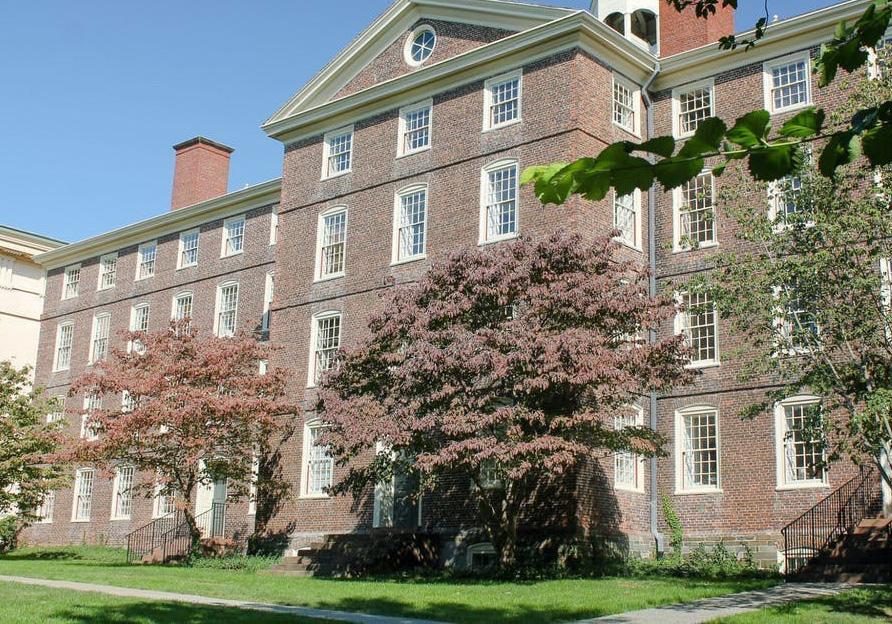
increase will provide a significant boost in revenue to support research, teaching and strategic initiatives, while positioning us to expand on our commitment to attracting and supporting students from a wide range of socioeconomic backgrounds,” Interim Provost Larry Larson said in the press release.
The tuition increases will be accompanied by a projected 9% increase in undergraduate financial aid equal to roughly $17 million, according to the press release, although the Corporation will not finalize the updated financial aid budget until its May meeting.
The tuition and salary increases were made based on recommendations from the University Resources Com-
mittee, which comprises the current provost and a small number of faculty, administrators, staff and students.
Salary increase pool, dorm naming and other Corporation updates
The meetings resulted in a 4% salary increase pool — the percent increase in salary that faculty and staff can receive for performance-based raises, promotions, equity adjustments and retention purposes — according to the press release. This pool is the second-largest in 12 years, after last year’s 4.25% increase pool.
“It remains essential that we sustain the University’s ability to compete for top talent and acknowledge the im -
mense contributions of our dedicated employees in making Brown a worldclass university,” Larson said in the release. “This year’s salary pool for both faculty and staff is fiscally responsible while ensuring the University’s capacity to remain an employer of choice in Providence, the state of Rhode Island and the greater region.”
In the meeting, the Corporation also approved the naming of the residence hall currently under construction at 250 Brook Street, according to a Feb. 13 Today@Brown announcement from President Christina Paxson P’19. The building will be named the Chen Family Hall in recognition of an anonymous gift to “help build, equip and maintain” the dorm.
Corporation members also reviewed the status of current research initiatives under development as part of the University’s Operational Plan for Investing in Research, which aims to increase institutional research output and visibility over the next five to seven years.
“There’s incredible potential for amazing research that can really have a big impact on people’s lives,” Larson told The Herald.
Spearheaded by Dean of the College Rashid Zia ’01, expanded course offerings will make it easier for students to fulfill their concentration requirements while exploring off-campus opportunities at the same time. “We want to actually encourage them in these unusual paths because we think they really add to their education,” Larson added.
University administrators are also preparing for multiple possibilities surrounding affirmative action, which faces an uncertain future with two upcoming Supreme Court decisions, according to Paxson’s Today@Brown announcement. At the meeting, the Corporation and Paxson established that “the Supreme Court’s decision will not change Brown’s commitment to diversity, which is central to preparing our students to thrive in the complex and changing settings they’ll encounter after they graduate,” Paxson wrote.
Since beginning his role as interim provost, Larson has been engaged in meetings with a group formed by former Provost Richard Locke P’18 to discuss potential options for University admissions policies, he said. “We’re preparing for a range of outcomes from the Court,” he said. “Our commitment … to recruiting students from a wide range of experiences, backgrounds, interests and perspectives — we’re absolutely unshakable on this.”
Administrators also discussed proposals for expanding off-campus learning options, including adding courses to the Summer Session and Winter Session terms and off-campus programs such as Brown in Washington, Larson said. That expansion would allow a wider range of students to take “more creative and unusual paths,” he said.
‘A global community’: Students fundraise for relief in Turkey, Syria
Event raises $31,000 and collects clothes, students discuss community support
BY KATHY WANG UNIVERSITY NEWS EDITOR
Last week, members of the Brown Cultural Association of Turkey fundraised for earthquake relief in Turkey and Syria, efforts that included donation stands in the Blue Room and a fundraising event on Saturday, according to Serdar Sungun ’23, president of CAT.
“We were united under one cause,” said Mira Sezer ’24, a CAT board member who helped lead the fundraising efforts. “I think this was probably the first time” that the Turkish community members all worked together.
“It was truly a product of teamwork,” she added. “Everybody was just trying to help.”
According to CAT Secretary Alara Kalfazade ’24, Saturday’s fundraiser featured a food station, a dessert station with baklavas, Turkish tea and coffee, henna, Turkish fortune-telling, Turkish marble painting and more. Located in the Stephen Robert ’62 Campus Center’s Leung Family Gallery, the event was sponsored by members of the local Turkish community, both at Brown and beyond.
Participants had to purchase two “stamps” — $5 each — upon entry. Each stamp could be exchanged for two meals of choice or an activity, Sezer said. Attendees could purchase more stamps whenever they wished to.
“At least 200, maybe even 300 people came throughout the five hours” of the event, said Nader Maarouf ’23, an e-board member of the Brown-RISD Arab Society, which provided support for the fundraiser.
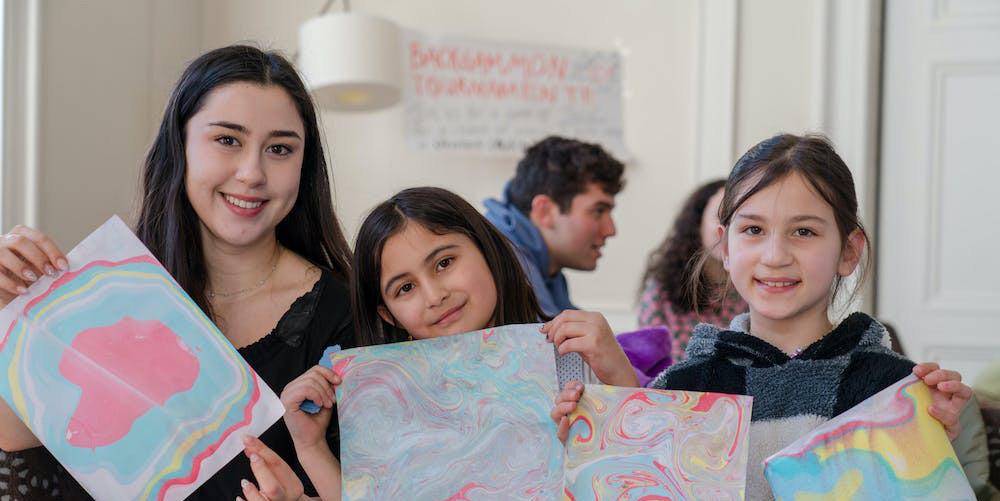
“There weren‘t only Turkish people” at the event, said Omer Chaudhry ’25, a member of the Pakistani Students Association at Brown, which also supported the event. “It seemed as if it was a global community.”
‘Our first priority’: The urgency of the situation
The severity of the earthquake’s impacts added urgency to CAT’s organizing efforts, Sungun said. “You’re kind of in a time crunch — it’s not like we can wait and then do something next month … we’re just trying to maximize whatever we can do.”
According to Sezer, CAT advertised the event through social media and word of mouth. “We announced that we were gonna have a stand at 8 a.m., (and the next day) we already had people waiting with bags” of supplies to donate, she said.
Sezer added that the group initially “had a whole system in place” to ensure that there would always be at least two organizers present at the fundraising tables, but there were
always seven or more people at the stand, all excited to help. Fundraising efforts that were just intended for Wednesday continued late into the end of the week.
The events became “our first … and only priority,” Sezer said.
Kalfazade told The Herald that the fundraising stands in the Blue Room garnered even more attention after CAT sent out a Feb. 9 Today@Brown announcement fielding donations of clothing items.
University community members are continuing their efforts to fundraise for earthquake relief. The Brown-RISD Arab Society will host a dinner screening of the Syrian documentary “The White Helmets” — named after the volunteer humanitarian organization saving people in turmoil in Turkey and Syria — on Wednesday night, with a $7 entry fee that will go to the White Helmets themselves, Maarouf said.
He added that the $7 fee is optional and that attendees are welcome to contribute more.
“This is an ongoing process,” Su-
ngun said. CAT’s fundraising efforts “will continue (through) next month, probably next year to actually reconstruct all the things that got wrecked.”
Matching money, donating clothes
According to Sungun, CAT raised a total of $14,000 — $10,000 from the Blue Room stands and $4,000 from Saturday’s fundraiser. One-third of the money raised on Saturday was donated to Syria through the Brown-RISD Arab Society.
Out of the nearly $13,000 left, CAT donated $9,000 to the AHBAP Foundation through Netflix — which matches $2 to $1, tripling the $9,000 into $27,000 — and $2,000 to Turkish Philanthropy Funds through Apple, which matches $1 to $1, doubling the $2,000 to $4,000, Sungun said. CAT is still working to match the remaining $2,000.
Sezer emphasized that the group chose which organizations to donate to after doing research and communicating with family members in Turkey.
“We’ve definitely done our best to ensure that … all these contributions
collected” reach the people in need who are affected by the earthquake, she said.
Maarouf told The Herald that the money the Brown-RISD Arab Society received from Saturday’s fundraiser was split and donated to the Karam Foundation and Syria Relief and Development.
“Although (the CAT) were doing all of the logistical management, one-third of the money from the donations that they gathered is going to victims in Syria,” Chaudhry said. “That was such a good gesture.”
People also donated clothing, including sweatshirts, sweaters, scarfs, beanies, blankets and comforters, shoes including boots and baby shoes, hygiene products such as sanitary pads and baby diapers and medicine, Kalfazade said, adding that CAT ended up bringing “three cars of clothes” to the Turkish Consulate General in Boston.
‘Our source of strength to keep going’
Sezer expressed gratitude for the community support CAT received during the fundraising efforts.
“I told my professor that I was gonna miss class this week (for fundraising, and) he said: ‘I’m happy to see that you have your priorities right,’ ” Sezer said. She added that Blue Room staff members gave them the contents of their tip boxes as donations, and one staff member donated boxes full of clothes and baby shoes.
This kindness “was our source of strength to keep going, because watching the news, talking to our friends whose families were directly affected, it’s not easy,” Sezer said. “Holding on to those sincere moments where you feel the love and support of your community and your friends was what really kept us going.”
HERALD FILE PHOTO
The tuition increases will be accompanied by a projected 9% increase in undergraduate financial aid equal to roughly $17 million.
COURTESY OF SERDAR SUNGUN
According to Serdar Sungun ’23, president of the Brown Cultural Associaton of Turkey, the group raised a total of $14,000, which, through matching donations, became $31,000 for earthquake relief.
